2013 BMW 535I XDRIVE GRAN TURISMO check engine
[x] Cancel search: check enginePage 207 of 240
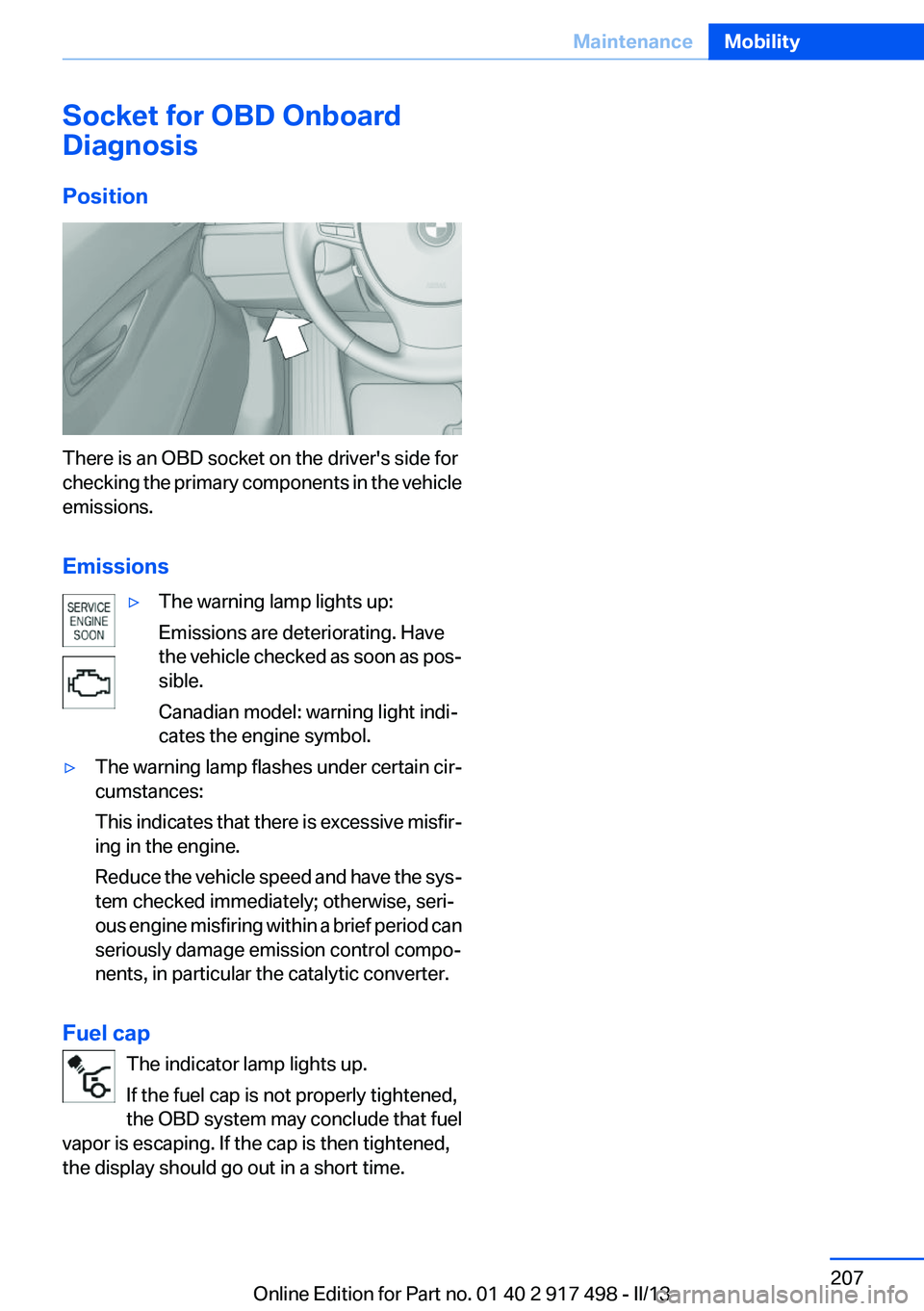
Socket for OBD Onboard
Diagnosis
Position
There is an OBD socket on the driver's side for
checking the primary components in the vehicle
emissions.
Emissions
▷The warning lamp lights up:
Emissions are deteriorating. Have
the vehicle checked as soon as pos‐
sible.
Canadian model: warning light indi‐
cates the engine symbol.▷The warning lamp flashes under certain cir‐
cumstances:
This indicates that there is excessive misfir‐
ing in the engine.
Reduce the vehicle speed and have the sys‐
tem checked immediately; otherwise, seri‐
ous engine misfiring within a brief period can
seriously damage emission control compo‐
nents, in particular the catalytic converter.
Fuel cap
The indicator lamp lights up.
If the fuel cap is not properly tightened,
the OBD system may conclude that fuel
vapor is escaping. If the cap is then tightened,
the display should go out in a short time.
Seite 207MaintenanceMobility207
Online Edition for Part no. 01 40 2 917 498 - II/13
Page 210 of 240
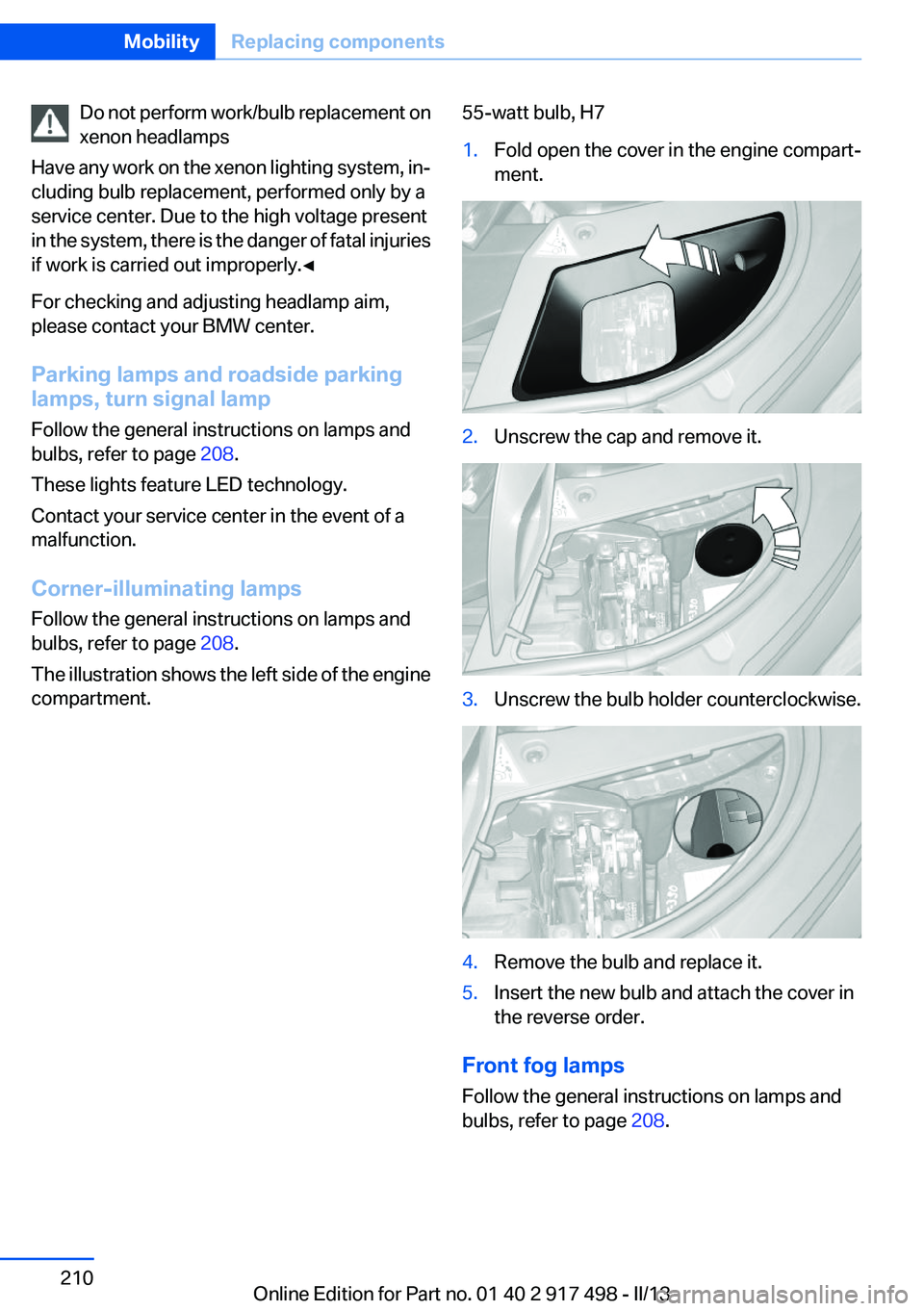
Do not perform work/bulb replacement on
xenon headlamps
Have any work on the xenon lighting system, in‐
cluding bulb replacement, performed only by a
service center. Due to the high voltage present
in the system, there is the danger of fatal injuries
if work is carried out improperly.◀
For checking and adjusting headlamp aim,
please contact your BMW center.
Parking lamps and roadside parking
lamps, turn signal lamp
Follow the general instructions on lamps and
bulbs, refer to page 208.
These lights feature LED technology.
Contact your service center in the event of a
malfunction.
Corner-illuminating lamps
Follow the general instructions on lamps and
bulbs, refer to page 208.
The illustration shows the left side of the engine
compartment.55-watt bulb, H71.Fold open the cover in the engine compart‐
ment.2.Unscrew the cap and remove it.3.Unscrew the bulb holder counterclockwise.4.Remove the bulb and replace it.5.Insert the new bulb and attach the cover in
the reverse order.
Front fog lamps
Follow the general instructions on lamps and
bulbs, refer to page 208.
Seite 210MobilityReplacing components210
Online Edition for Part no. 01 40 2 917 498 - II/13
Page 213 of 240
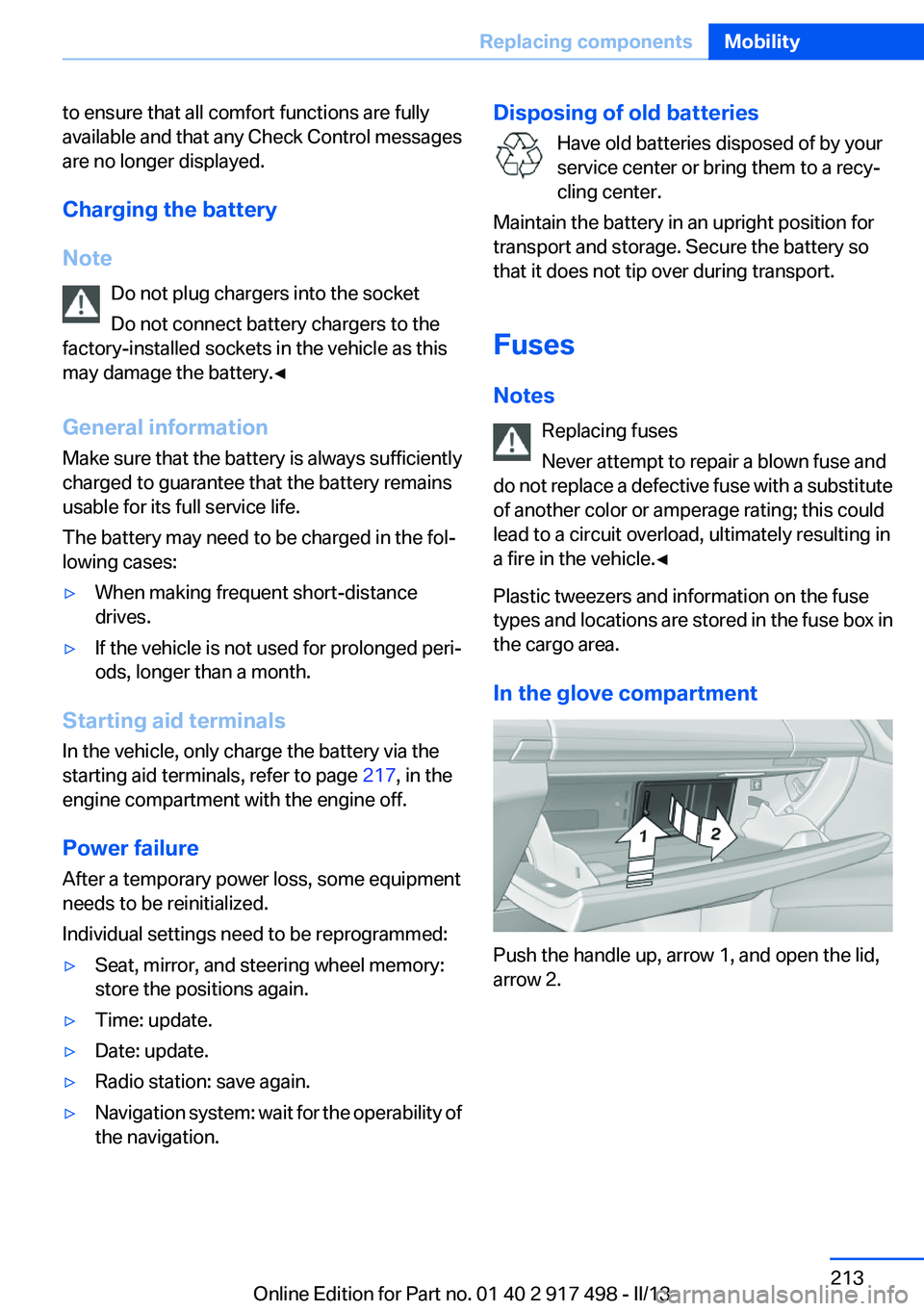
to ensure that all comfort functions are fully
available and that any Check Control messages
are no longer displayed.
Charging the battery
Note Do not plug chargers into the socket
Do not connect battery chargers to the
factory-installed sockets in the vehicle as this
may damage the battery.◀
General information
Make sure that the battery is always sufficiently
charged to guarantee that the battery remains
usable for its full service life.
The battery may need to be charged in the fol‐
lowing cases:▷When making frequent short-distance
drives.▷If the vehicle is not used for prolonged peri‐
ods, longer than a month.
Starting aid terminals
In the vehicle, only charge the battery via the
starting aid terminals, refer to page 217, in the
engine compartment with the engine off.
Power failure
After a temporary power loss, some equipment
needs to be reinitialized.
Individual settings need to be reprogrammed:
▷Seat, mirror, and steering wheel memory:
store the positions again.▷Time: update.▷Date: update.▷Radio station: save again.▷Navigation system: wait for the operability of
the navigation.Disposing of old batteries
Have old batteries disposed of by your
service center or bring them to a recy‐
cling center.
Maintain the battery in an upright position for
transport and storage. Secure the battery so
that it does not tip over during transport.
Fuses
Notes Replacing fuses
Never attempt to repair a blown fuse and
do not replace a defective fuse with a substitute
of another color or amperage rating; this could
lead to a circuit overload, ultimately resulting in
a fire in the vehicle.◀
Plastic tweezers and information on the fuse
types and locations are stored in the fuse box in
the cargo area.
In the glove compartment
Push the handle up, arrow 1, and open the lid,
arrow 2.
Seite 213Replacing componentsMobility213
Online Edition for Part no. 01 40 2 917 498 - II/13
Page 217 of 240
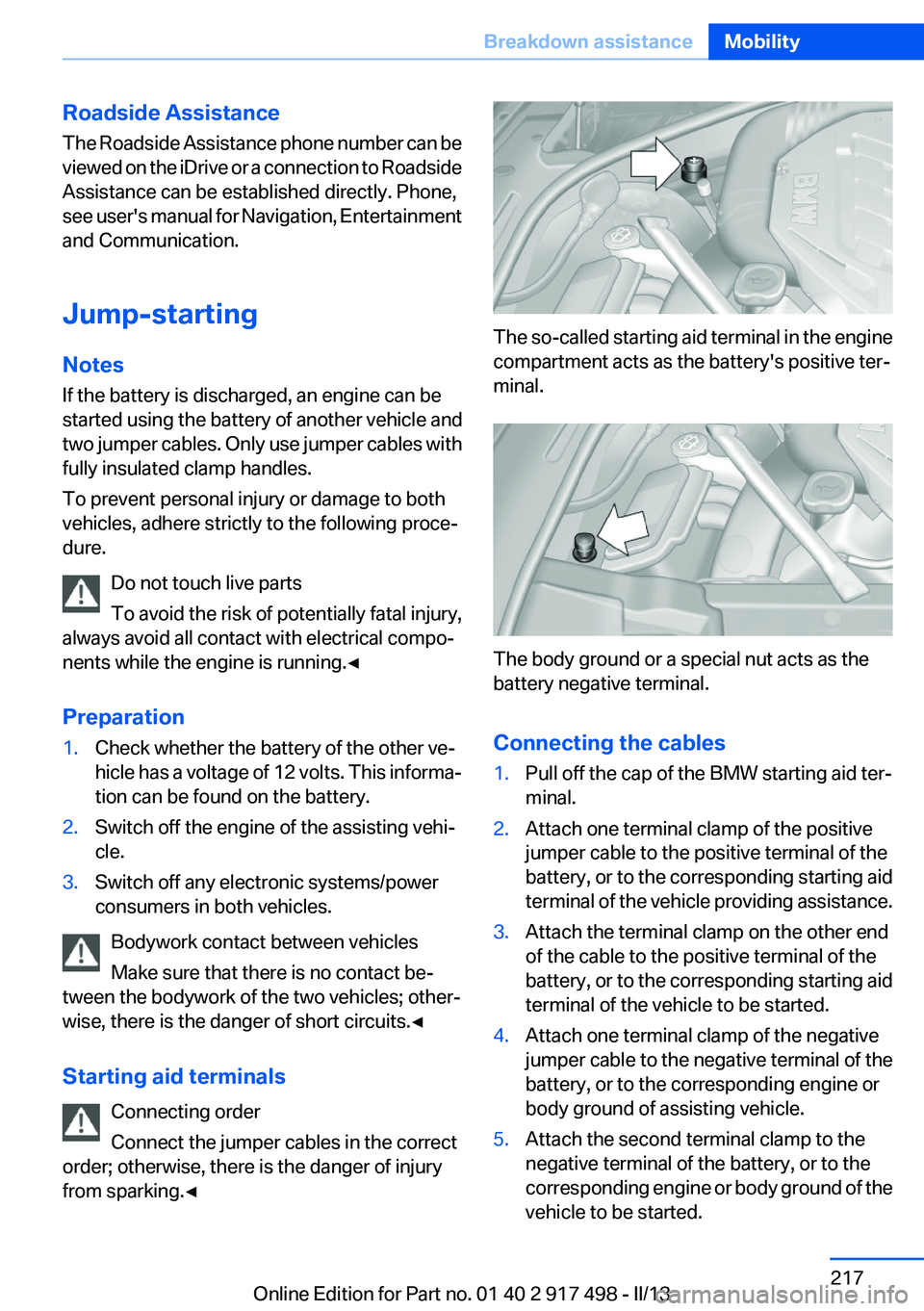
Roadside Assistance
The Roadside Assistance phone number can be
viewed on the iDrive or a connection to Roadside
Assistance can be established directly. Phone,
see user's manual for Navigation, Entertainment
and Communication.
Jump-starting
Notes
If the battery is discharged, an engine can be
started using the battery of another vehicle and
two jumper cables. Only use jumper cables with
fully insulated clamp handles.
To prevent personal injury or damage to both
vehicles, adhere strictly to the following proce‐
dure.
Do not touch live parts
To avoid the risk of potentially fatal injury,
always avoid all contact with electrical compo‐
nents while the engine is running.◀
Preparation1.Check whether the battery of the other ve‐
hicle has a voltage of 12 volts. This informa‐
tion can be found on the battery.2.Switch off the engine of the assisting vehi‐
cle.3.Switch off any electronic systems/power
consumers in both vehicles.
Bodywork contact between vehicles
Make sure that there is no contact be‐
tween the bodywork of the two vehicles; other‐
wise, there is the danger of short circuits.◀
Starting aid terminals Connecting order
Connect the jumper cables in the correct
order; otherwise, there is the danger of injury
from sparking.◀
The so-called starting aid terminal in the engine
compartment acts as the battery's positive ter‐
minal.
The body ground or a special nut acts as the
battery negative terminal.
Connecting the cables
1.Pull off the cap of the BMW starting aid ter‐
minal.2.Attach one terminal clamp of the positive
jumper cable to the positive terminal of the
battery, or to the corresponding starting aid
terminal of the vehicle providing assistance.3.Attach the terminal clamp on the other end
of the cable to the positive terminal of the
battery, or to the corresponding starting aid
terminal of the vehicle to be started.4.Attach one terminal clamp of the negative
jumper cable to the negative terminal of the
battery, or to the corresponding engine or
body ground of assisting vehicle.5.Attach the second terminal clamp to the
negative terminal of the battery, or to the
corresponding engine or body ground of the
vehicle to be started.Seite 217Breakdown assistanceMobility217
Online Edition for Part no. 01 40 2 917 498 - II/13
Page 218 of 240
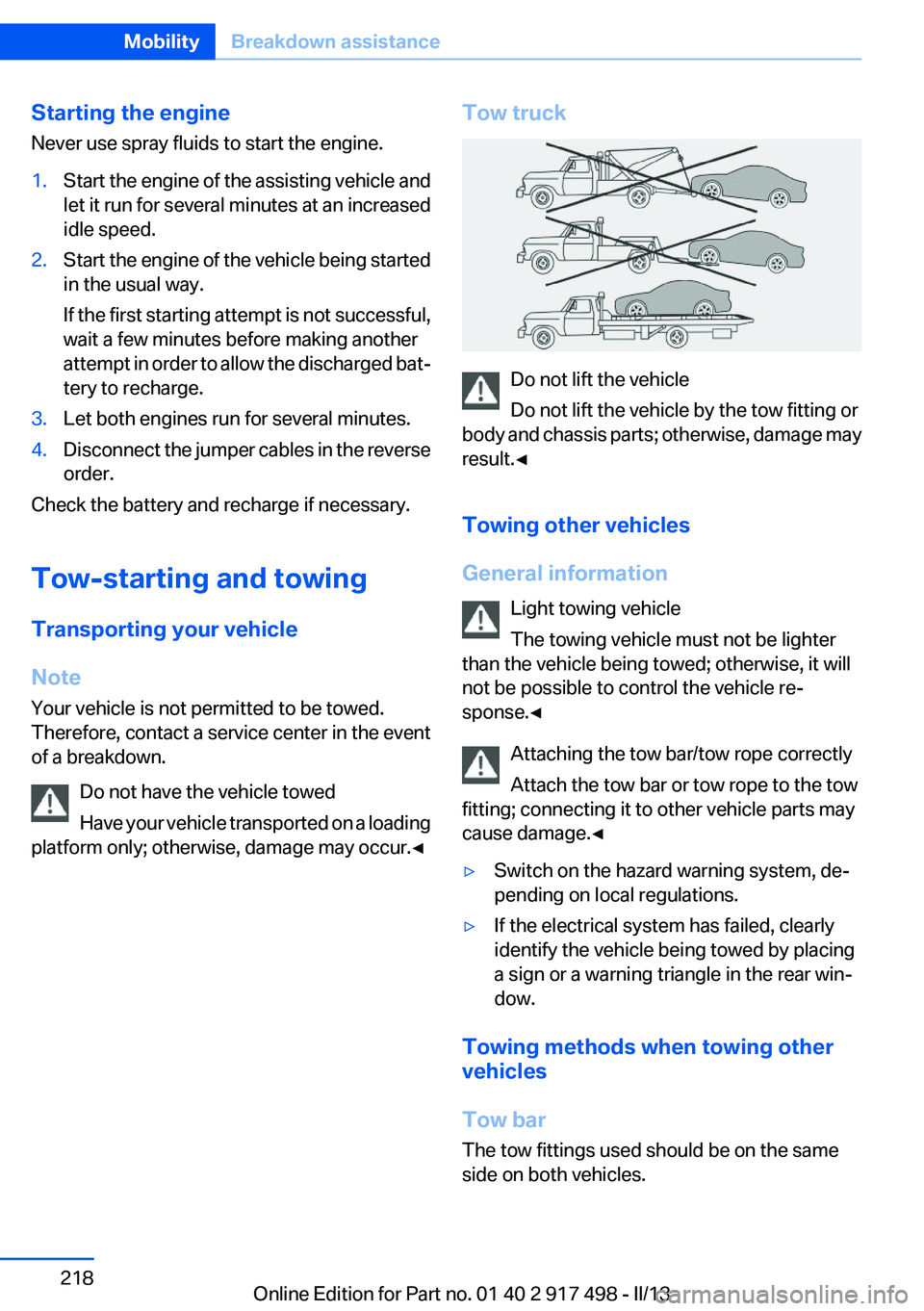
Starting the engine
Never use spray fluids to start the engine.1.Start the engine of the assisting vehicle and
let it run for several minutes at an increased
idle speed.2.Start the engine of the vehicle being started
in the usual way.
If the first starting attempt is not successful,
wait a few minutes before making another
attempt in order to allow the discharged bat‐
tery to recharge.3.Let both engines run for several minutes.4.Disconnect the jumper cables in the reverse
order.
Check the battery and recharge if necessary.
Tow-starting and towing
Transporting your vehicle
Note
Your vehicle is not permitted to be towed.
Therefore, contact a service center in the event
of a breakdown.
Do not have the vehicle towed
Have your vehicle transported on a loading
platform only; otherwise, damage may occur.◀
Tow truck
Do not lift the vehicle
Do not lift the vehicle by the tow fitting or
body and chassis parts; otherwise, damage may
result.◀
Towing other vehicles
General information Light towing vehicle
The towing vehicle must not be lighter
than the vehicle being towed; otherwise, it will
not be possible to control the vehicle re‐
sponse.◀
Attaching the tow bar/tow rope correctly
Attach the tow bar or tow rope to the tow
fitting; connecting it to other vehicle parts may
cause damage.◀
▷Switch on the hazard warning system, de‐
pending on local regulations.▷If the electrical system has failed, clearly
identify the vehicle being towed by placing
a sign or a warning triangle in the rear win‐
dow.
Towing methods when towing other
vehicles
Tow bar
The tow fittings used should be on the same
side on both vehicles.
Seite 218MobilityBreakdown assistance218
Online Edition for Part no. 01 40 2 917 498 - II/13
Page 221 of 240
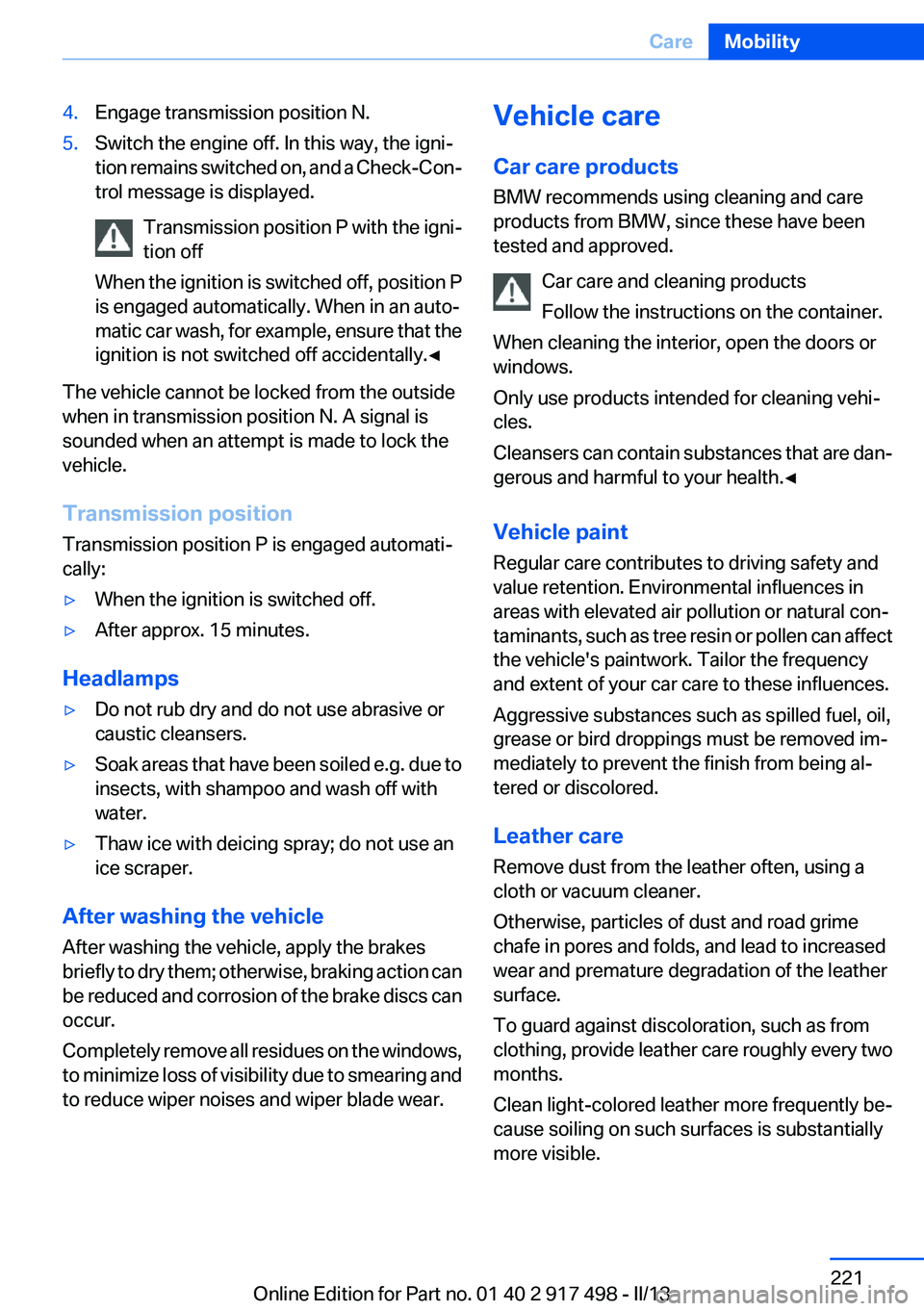
4.Engage transmission position N.5.Switch the engine off. In this way, the igni‐
tion remains switched on, and a Check-Con‐
trol message is displayed.
Transmission position P with the igni‐
tion off
When the ignition is switched off, position P
is engaged automatically. When in an auto‐
matic car wash, for example, ensure that the
ignition is not switched off accidentally.◀
The vehicle cannot be locked from the outside
when in transmission position N. A signal is
sounded when an attempt is made to lock the
vehicle.
Transmission position
Transmission position P is engaged automati‐
cally:
▷When the ignition is switched off.▷After approx. 15 minutes.
Headlamps
▷Do not rub dry and do not use abrasive or
caustic cleansers.▷Soak areas that have been soiled e.g. due to
insects, with shampoo and wash off with
water.▷Thaw ice with deicing spray; do not use an
ice scraper.
After washing the vehicle
After washing the vehicle, apply the brakes
briefly to dry them; otherwise, braking action can
be reduced and corrosion of the brake discs can
occur.
Completely remove all residues on the windows,
to minimize loss of visibility due to smearing and
to reduce wiper noises and wiper blade wear.
Vehicle care
Car care products
BMW recommends using cleaning and care
products from BMW, since these have been
tested and approved.
Car care and cleaning products
Follow the instructions on the container.
When cleaning the interior, open the doors or
windows.
Only use products intended for cleaning vehi‐
cles.
Cleansers can contain substances that are dan‐
gerous and harmful to your health.◀
Vehicle paint
Regular care contributes to driving safety and
value retention. Environmental influences in
areas with elevated air pollution or natural con‐
taminants, such as tree resin or pollen can affect
the vehicle's paintwork. Tailor the frequency
and extent of your car care to these influences.
Aggressive substances such as spilled fuel, oil,
grease or bird droppings must be removed im‐
mediately to prevent the finish from being al‐
tered or discolored.
Leather care
Remove dust from the leather often, using a
cloth or vacuum cleaner.
Otherwise, particles of dust and road grime
chafe in pores and folds, and lead to increased
wear and premature degradation of the leather
surface.
To guard against discoloration, such as from
clothing, provide leather care roughly every two
months.
Clean light-colored leather more frequently be‐
cause soiling on such surfaces is substantially
more visible.Seite 221CareMobility221
Online Edition for Part no. 01 40 2 917 498 - II/13
Page 233 of 240
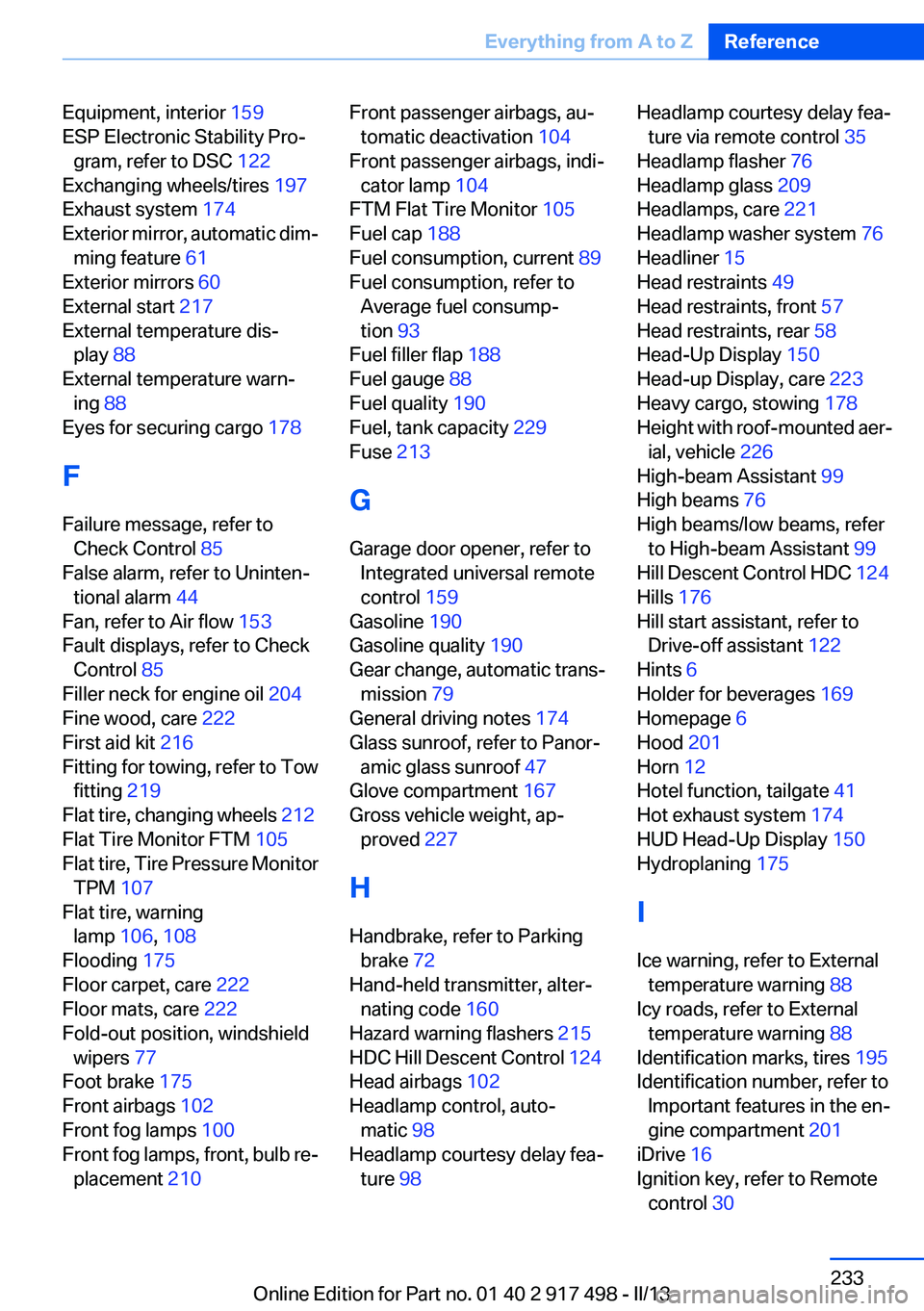
Equipment, interior 159
ESP Electronic Stability Pro‐ gram, refer to DSC 122
Exchanging wheels/tires 197
Exhaust system 174
Exterior mirror, automatic dim‐ ming feature 61
Exterior mirrors 60
External start 217
External temperature dis‐ play 88
External temperature warn‐ ing 88
Eyes for securing cargo 178
F
Failure message, refer to Check Control 85
False alarm, refer to Uninten‐ tional alarm 44
Fan, refer to Air flow 153
Fault displays, refer to Check Control 85
Filler neck for engine oil 204
Fine wood, care 222
First aid kit 216
Fitting for towing, refer to Tow fitting 219
Flat tire, changing wheels 212
Flat Tire Monitor FTM 105
Flat tire, Tire Pressure Monitor TPM 107
Flat tire, warning lamp 106, 108
Flooding 175
Floor carpet, care 222
Floor mats, care 222
Fold-out position, windshield wipers 77
Foot brake 175
Front airbags 102
Front fog lamps 100
Front fog lamps, front, bulb re‐ placement 210 Front passenger airbags, au‐
tomatic deactivation 104
Front passenger airbags, indi‐ cator lamp 104
FTM Flat Tire Monitor 105
Fuel cap 188
Fuel consumption, current 89
Fuel consumption, refer to Average fuel consump‐
tion 93
Fuel filler flap 188
Fuel gauge 88
Fuel quality 190
Fuel, tank capacity 229
Fuse 213
G
Garage door opener, refer to Integrated universal remote
control 159
Gasoline 190
Gasoline quality 190
Gear change, automatic trans‐ mission 79
General driving notes 174
Glass sunroof, refer to Panor‐ amic glass sunroof 47
Glove compartment 167
Gross vehicle weight, ap‐ proved 227
H
Handbrake, refer to Parking brake 72
Hand-held transmitter, alter‐ nating code 160
Hazard warning flashers 215
HDC Hill Descent Control 124
Head airbags 102
Headlamp control, auto‐ matic 98
Headlamp courtesy delay fea‐ ture 98 Headlamp courtesy delay fea‐
ture via remote control 35
Headlamp flasher 76
Headlamp glass 209
Headlamps, care 221
Headlamp washer system 76
Headliner 15
Head restraints 49
Head restraints, front 57
Head restraints, rear 58
Head-Up Display 150
Head-up Display, care 223
Heavy cargo, stowing 178
Height with roof-mounted aer‐ ial, vehicle 226
High-beam Assistant 99
High beams 76
High beams/low beams, refer to High-beam Assistant 99
Hill Descent Control HDC 124
Hills 176
Hill start assistant, refer to Drive-off assistant 122
Hints 6
Holder for beverages 169
Homepage 6
Hood 201
Horn 12
Hotel function, tailgate 41
Hot exhaust system 174
HUD Head-Up Display 150
Hydroplaning 175
I
Ice warning, refer to External temperature warning 88
Icy roads, refer to External temperature warning 88
Identification marks, tires 195
Identification number, refer to Important features in the en‐
gine compartment 201
iDrive 16
Ignition key, refer to Remote control 30 Seite 233Everything from A to ZReference233
Online Edition for Part no. 01 40 2 917 498 - II/13
Page 235 of 240
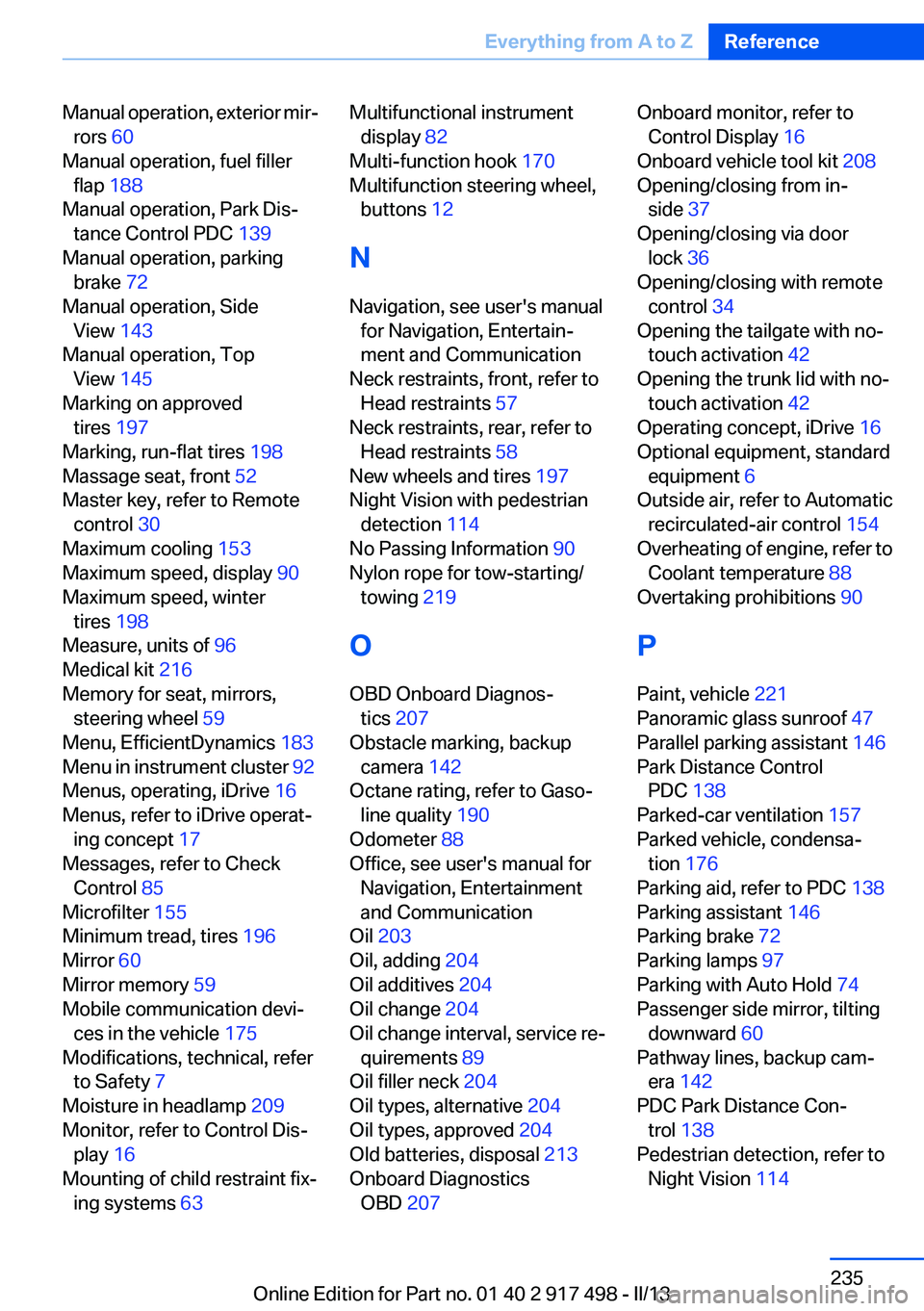
Manual operation, exterior mir‐rors 60
Manual operation, fuel filler flap 188
Manual operation, Park Dis‐ tance Control PDC 139
Manual operation, parking brake 72
Manual operation, Side View 143
Manual operation, Top View 145
Marking on approved tires 197
Marking, run-flat tires 198
Massage seat, front 52
Master key, refer to Remote control 30
Maximum cooling 153
Maximum speed, display 90
Maximum speed, winter tires 198
Measure, units of 96
Medical kit 216
Memory for seat, mirrors, steering wheel 59
Menu, EfficientDynamics 183
Menu in instrument cluster 92
Menus, operating, iDrive 16
Menus, refer to iDrive operat‐ ing concept 17
Messages, refer to Check Control 85
Microfilter 155
Minimum tread, tires 196
Mirror 60
Mirror memory 59
Mobile communication devi‐ ces in the vehicle 175
Modifications, technical, refer to Safety 7
Moisture in headlamp 209
Monitor, refer to Control Dis‐ play 16
Mounting of child restraint fix‐ ing systems 63 Multifunctional instrument
display 82
Multi-function hook 170
Multifunction steering wheel, buttons 12
N
Navigation, see user's manual for Navigation, Entertain‐
ment and Communication
Neck restraints, front, refer to Head restraints 57
Neck restraints, rear, refer to Head restraints 58
New wheels and tires 197
Night Vision with pedestrian detection 114
No Passing Information 90
Nylon rope for tow-starting/ towing 219
O
OBD Onboard Diagnos‐ tics 207
Obstacle marking, backup camera 142
Octane rating, refer to Gaso‐ line quality 190
Odometer 88
Office, see user's manual for Navigation, Entertainment
and Communication
Oil 203
Oil, adding 204
Oil additives 204
Oil change 204
Oil change interval, service re‐ quirements 89
Oil filler neck 204
Oil types, alternative 204
Oil types, approved 204
Old batteries, disposal 213
Onboard Diagnostics OBD 207 Onboard monitor, refer to
Control Display 16
Onboard vehicle tool kit 208
Opening/closing from in‐ side 37
Opening/closing via door lock 36
Opening/closing with remote control 34
Opening the tailgate with no- touch activation 42
Opening the trunk lid with no- touch activation 42
Operating concept, iDrive 16
Optional equipment, standard equipment 6
Outside air, refer to Automatic recirculated-air control 154
Overheating of engine, refer to Coolant temperature 88
Overtaking prohibitions 90
P
Paint, vehicle 221
Panoramic glass sunroof 47
Parallel parking assistant 146
Park Distance Control PDC 138
Parked-car ventilation 157
Parked vehicle, condensa‐ tion 176
Parking aid, refer to PDC 138
Parking assistant 146
Parking brake 72
Parking lamps 97
Parking with Auto Hold 74
Passenger side mirror, tilting downward 60
Pathway lines, backup cam‐ era 142
PDC Park Distance Con‐ trol 138
Pedestrian detection, refer to Night Vision 114 Seite 235Everything from A to ZReference235
Online Edition for Part no. 01 40 2 917 498 - II/13